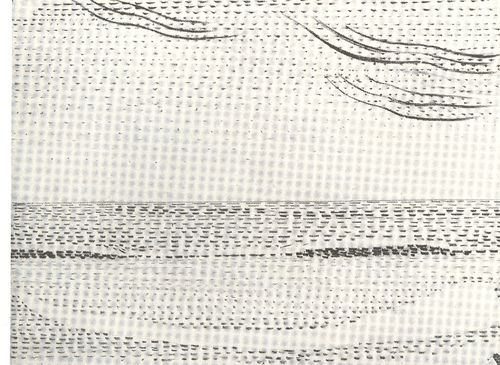JF Ptak Science Books LLC Post 758 Blog Bookstore
I wonder if Henry van de Velde (1863-1957) as one of the earliest people to paint what he saw as an x-ray of the stuff of existence. His artwork, “Sun at Ocean (Rhythmic Synthesis”) which I found in Werner Hoffman’s Turning Points in Twentieth century Art, 1890-1917 and which was executed in 1888/9, looks to me to be absolutely incredible 
for its time, a nearly non-representational, proto-abstract something, done three decades before these genres came into being.
His representation of known objects seems to be nearly, completely, removed—what we have left here is the representation, or impression, of the subject of the painting. We can see the sky and sun and ocean there still, but just barely: their representation in skeletal form shows us the bare bones of the world, like a pre-X-Ray X-Ray (which didn’t come around until the very ready and able Wilhelm Roentgen bumped into it in the winter of 1895).
It is hard to think of how unusual this artwork would’ve been, even given some historical consulting. The Impressionists, who had crept up into the artworld existence to their first show in 1874, were seen as being a radical, revolutionary, avant garde movement. Their reception was not a cordial one, as they were threatening the established order of the instructionally-regulated world of art that had stood for centuries. Van de Velde’s work was far outside of Impressionism, or at least it would seem so to me, making it more radical still.
I’m not sure where van de Velde’s work stands in the history of Modernism (ca. 1875-1916, when virtually very major discipline encountered massive change). It doesn’t seem to be a prototype for abstract art, which doesn’t seem to have precedents in the 19th century outside of found-art in mathematics of the fourth dimension. This new world of art seems to begin suddenly in 1907 with the work of Braque and Picasso, and then Marcel Duchamp, and Nayral (1910) and Gris (1911), followed by many others including Gleizes and Marcoussis and Metzinger and Villon (all in 1912). The Impressionists on the other hand have a very rich history of impressionistic works leading up to their major debut in 1874: like Courbet’s “Portrait of Baudelaire” (1848/50), or Cezanne’s “Man with a Blue Cap” (1865), or Bourdin’s “Cloud Study” (ca. 1859), on Monet’s “Still Life” (1859, with the disappearing bread), or Degas’ “Semiarmis…” (1861) or Pissarro’s “The Road” (1864), or the glorious modern self portrait of Cezanne done in 1865. There are many others.
Van de Velde’s art leaves me puzzled, probably because I really don’t know about the painting phase of his life (an activity he gave up in 1892); probably because I just don’t know enough, and am not art scholar. I don’t know why this isn’t significant, unless, of course, the work was not seen, or was unknown, or was simply rejected.
But that still leaves us with the artwork itself: a skeleton. Scaffolding. Stage setting. Fragments of the remaining object. Simplification: a rediscovery of the material of the world reduced to its barest essentials, to a geometrical simplicity of nothing but lines, dashes, suggesting a larger form. It is the amount of weight in the “suggestion” of form that makes this work so incredible—up to this time, I think, there weren’t any other works of art where so much was open to interpretation, and so much of the optical characteristics of the subject had been removed. (Rodin’s statue of Balzac, showing the author seemingly ripping himself from his stone, was much hated when it was shown in 1897, the “unfinished” parts seen as ugly and crude by many. This would seem a good example of the weight of suggested form in pre-20th century art.)
1889. Decades before Malevich, Rodchenko, Balla, Severini, Tatlin, El Lissitzky, Klee, Kandinsky. (And Mondrian, the biggest question mark for me and greatest possible inheritor of this work.) I just don’t get it where van de Velde “went”. He did go on to a terrific career in design and architecture in worlds outside of this effort; I just don’t know what happened to “Sky and Sea'...maybe Henry just didn't like itpreferring his gorgeous nouveau design motifs. After all, he survived this artwork by almost 70 years (!), and perhaps he laid it aside as a youthful flourish. As I said, I really don't know.



Comments